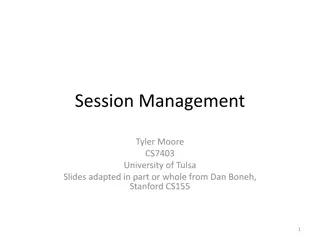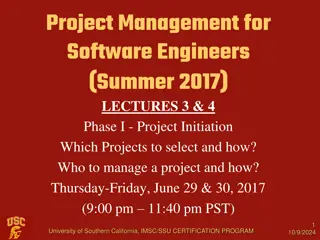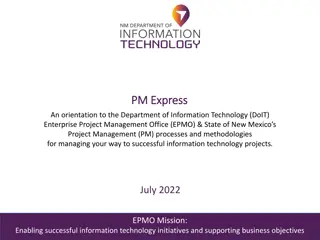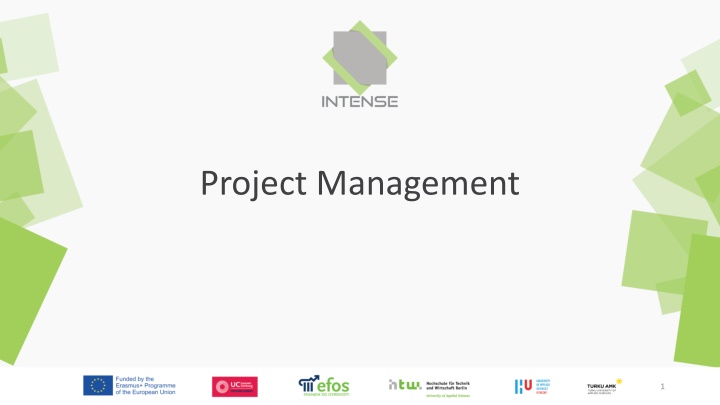
Effective Project Management Strategies for Success
Learn about initiating a project, project selection, conceptual development, and portfolio management. Discover key strategies for successful project portfolio management, generating project ideas, and group work. Develop and plan a project with practical steps outlined.
Download Presentation

Please find below an Image/Link to download the presentation.
The content on the website is provided AS IS for your information and personal use only. It may not be sold, licensed, or shared on other websites without obtaining consent from the author. If you encounter any issues during the download, it is possible that the publisher has removed the file from their server.
You are allowed to download the files provided on this website for personal or commercial use, subject to the condition that they are used lawfully. All files are the property of their respective owners.
The content on the website is provided AS IS for your information and personal use only. It may not be sold, licensed, or shared on other websites without obtaining consent from the author.
E N D
Presentation Transcript
3. Initiating a Project 3. Initiating a Project 1. Project Selection 2. Conceptual Development 2 2
Learning Objectives Learning Objectives After completing this chapter, students will be able to: Explain criteria for a useful project selection/screening model Understand how to employ scoring models to select projects Recognise the challenges that arise in maintaining an optimal project portfolio for an organisation Understand the three keys to successful project portfolio management 3
Portfolio Management Portfolio Management Portfolio Programme A Programme B Project D Project A Project B Project A Project B Project C 4
Project Group Work for This Course Project Group Work for This Course During this course you are to develop and plan a project of your choice Today: Choose a team of 4 5 Students Needs to be able to be in working mode in 2 weeks Develop different project ideas with your team Can be real or fictitious Choose a project idea that your team will follow for the rest of this course Summer Term 2017 5
Generating Project Ideas Generating Project Ideas Rational Thinking Examining your own strengths and interests Looking at past project titles Discussion Searching literature Scanning media 6
Generating Project Ideas Generating Project Ideas Creative Thinking Keeping a notebook of ideas Exploring personal preferences using past projects Relevance trees Brainstorming 7
Generating Project Ideas Generating Project Ideas - - Approach Approach Step 1: Silent brainstorm (5 minutes) Write down your thoughts and/or ideas on post-its/cards. If you want, you can visualise your ideas with little drawings; use one post-it/card per idea. Step 2: Sharing (10 minutes) Present your ideas to the other group members and put your post-its/cards on the table or a flip-chart Other group members can add ideas spontaneously Step 3: Voting (5 minutes) Use the two stickers to vote for the two project ideas that you like most Choose the two project ideas with the most votes Step 4: Specifying your project ideas (10 minutes) Specify the two remaining project ideas within your team: what could your project look like? Collect your ideas on post-its/cards 8
Quality Factors of Screening Models Quality Factors of Screening Models Realism Comparability Capability Cost Effectiveness Flexibility Ease of Use Source: Souder and Sherman (1994) 9 9
Screening & Selection Issues Screening & Selection Issues 1. 1. Risk Risk unpredictability unpredictabilityto the firm Technical Financial Safety Quality Legal exposure 2. Commercial 2. Commercial market potential market potential a. b. c. d. e. a. a. Expected return on investment Expected return on investment b. b. Payback period Payback period c. c. Potential market share Potential market share d. d. Long Long- -term market dominance term market dominance e. e. Initial cash outlay Initial cash outlay f. f. Ability to generate future business/new markets Ability to generate future business/new markets Source: Pinto (2015) 10 10
Screening & Selection Issues Screening & Selection Issues 3. 3. Internal operating Internal operating changes in firm operations Need to develop/train employees Change in workforce size or composition Change in physical environment Change in manufacturing or service operations 4. Additional a. Patent protection a. b. b. Impact on company s image c. Strategic fit c. d. All models only partially reflect reality and have both objective and subjective factors imbedded Source: Pinto (2015) 11 11
Approaches to Project Screening Approaches to Project Screening Simplified Scoring Models Analytic Hierarchy Process Checklist Model Profile Models Financial Models 12 12
Checklist Model Simplified Checklist Model Simplified Checklist Model Performance on Criteria High Medium Low Project Project Alpha Project Beta Project Gamma Criteria Cost Profit Potential Time to Market Development Risks X X X X Cost Profit Potential Time to Market Development Risks X X X X Cost Profit Potential Time to Market Development Risks X X X X Source: Pinto (2015) 13 13
Simplified Scoring Models Simple Scoring Model Simple Scoring Model = ( ) Score Weight Score Source: Pinto (2015) 14 14
Analytic Hierarchy Process Analytic Hierarchy Process Analytic Hierarchy Process The AHP is a four-step process: 1. Construct a hierarchy of criteria and sub criteria criteria and sub criteria 2. Allocate weights Allocate weights to criteria 3. Assign numerical values numerical values to evaluation dimensions 4. Determine Determine scores scores by adding the products of numeric evaluations and weights Unlike the simple scoring model, these scores can be compared! Unlike the simple scoring model, these scores can be compared! 15 15
Analytic Hierarchy Process Sample AHP with Rankings Sample AHP with Rankings for Salient Selection Criteria for Salient Selection Criteria Source: Pinto (2015) 16
Profile Models Profile Models Profile Models X7 X6 Maximum Desired Risk Criteriaselection as axes X2 Risk X4 X5 Efficient Frontier Rating each project on criteria X3 X1 Minimum Desired Return Return Source: Pinto (2015) 17
Financial Models Financial Models Financial Models - - Payback Period Payback Period Determines how long it takes for a project to reach a breakeven point Investment Annual Cash Savings = Payback Period Cash flows should be discounted Lower numbers are better (faster payback) 18 18
Payback Period Example Payback Period Example Financial Models Divide the cumulative amount by the cash flow amount in the first positive year and subtract from that year to find out the moment the project breaks even 3 - 50,000 = 2.857 350,000 Source: Pinto (2015) 19
Proactive Portfolio Matrix Proactive Portfolio Matrix Source: Pinto (2015)
Generating Project Ideas Generating Project Ideas - - Approach Approach Step 5: Select a project As a team, review the list of generated projects Discuss selection criteria for your projects (remember, it lasts the entire semester! So, consider your schedule, other courses (your portfolio ) and issues influencing selection discussed before) Choose one of the screening models we discussed (consider the quality criteria for screening models when choosing an appropriate model) Apply the screening model to come to a final decision of your project Write down your final project idea in one sentence and be as clear and as precise as possible Be ready to present your project in class within one sentence 21
Summary Summary Choosing the right screening model and considering the project portfolio is essential when choosing a new product Some of the more common project selection methods are Checklist model, Simplified screening model, Analytical hierarchy model, profile models and financial models General portfolio management is the systematic process of selecting, supporting, and managing the firm s collection of projects 22 22
Learning Objectives Learning Objectives After completing this chapter, students will be able to: Explain criteria for a useful project selection/screening model Understand how to employ scoring models to select projects Recognise the challenges that arise in maintaining an optimal project portfolio for an organisation Understand the three keys to successful project portfolio management 23
References References Horine, Greg (2013): Absolute Beginner s Guide to Project Management, Que Sams/Pearson Education, 3rded. Pinto, J. K. (2015): Project management. Achieving competitive advantage, Pearson Education, Harlow, Essex, 4thed. Project Management Institute (2013): A Guide to the Project Management Body of Knowledge: PMBOK(R) Guide, Project Management Institute; 5thed. Souder, W. E., & Sherman, J. D. (1994). Managing new technology development. Columbia University Press. 24



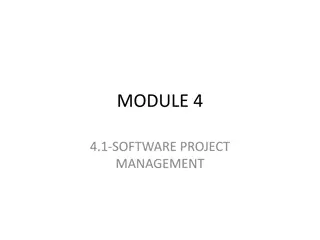
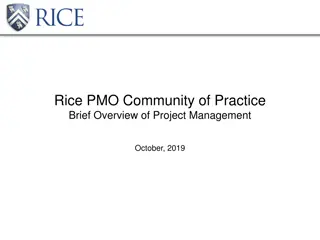
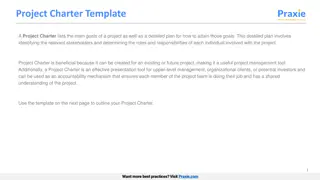
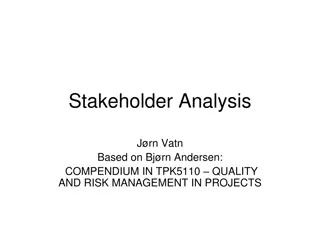
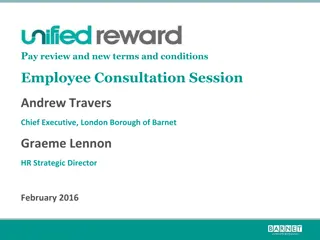
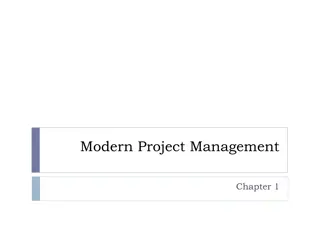
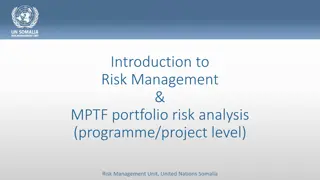
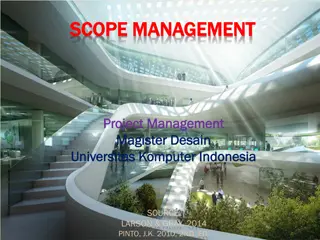
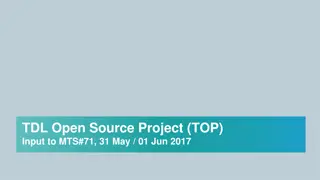

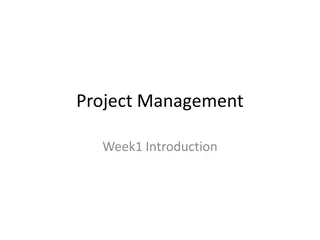
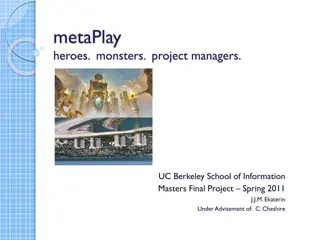

![Project Initiation Document for [Insert.Project.name] [Insert.Project.number]](/thumb/226757/project-initiation-document-for-insert-project-name-insert-project-number.jpg)
